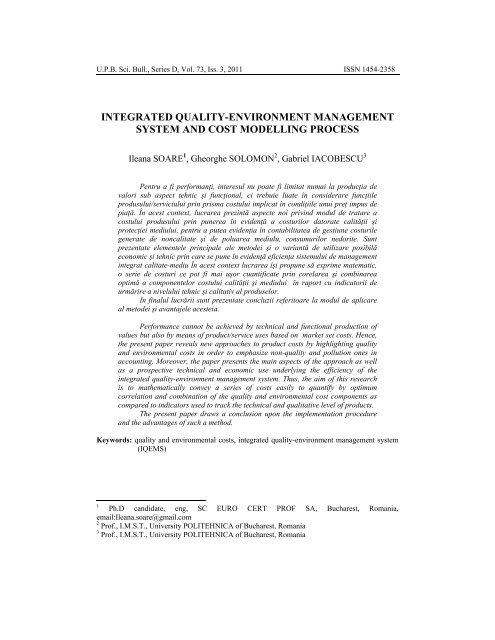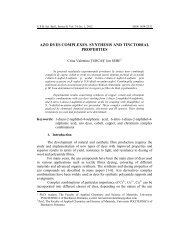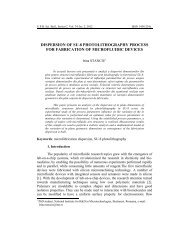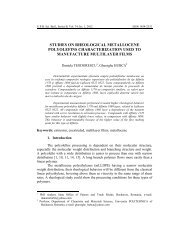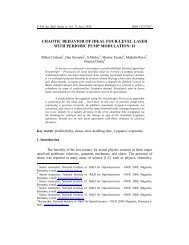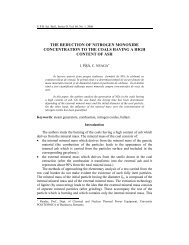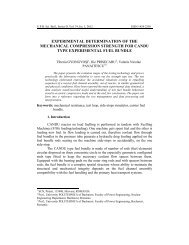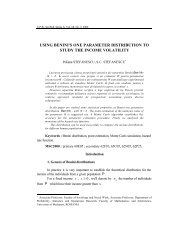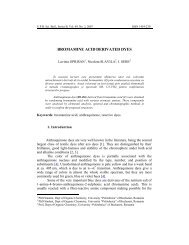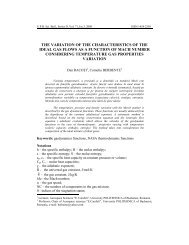integrated quality-environment management ... - Scientific Bulletin
integrated quality-environment management ... - Scientific Bulletin
integrated quality-environment management ... - Scientific Bulletin
Create successful ePaper yourself
Turn your PDF publications into a flip-book with our unique Google optimized e-Paper software.
U.P.B. Sci. Bull., Series D, Vol. 73, Iss. 3, 2011 ISSN 1454-2358<br />
INTEGRATED QUALITY-ENVIRONMENT MANAGEMENT<br />
SYSTEM AND COST MODELLING PROCESS<br />
Ileana SOARE 1 , Gheorghe SOLOMON 2 , Gabriel IACOBESCU 3<br />
Pentru a fi performanţi, interesul nu poate fi limitat numai la producţia de<br />
valori sub aspect tehnic şi funcţional, ci trebuie luate în considerare funcţiile<br />
produsului/serviciului prin prisma costului implicat în condiţiile unui preţ impus de<br />
piaţă. În acest context, lucrarea prezintă aspecte noi privind modul de tratare a<br />
costului produsului prin punerea în evidenţă a costurilor datorate calităţii şi<br />
protecţiei mediului, pentru a putea evidenţia în contabilitatea de gestiune costurile<br />
generate de noncalitate şi de poluarea mediulu, consumurilor nedorite. Sunt<br />
prezentate elementele principale ale metodei şi o variantă de utilizare posibilă<br />
economic şi tehnic prin care se pune în evidenţă eficienţa sistemului de <strong>management</strong><br />
integrat calitate-mediu În acest context lucrarea îşi propune să exprime matematic,<br />
o serie de costuri ce pot fi mai uşor cuantificate prin corelarea şi combinarea<br />
optimă a componentelor costului calităţii şi mediului în raport cu indicatorii de<br />
urmărire a nivelului tehnic şi calitativ al produselor.<br />
In finalul lucrării sunt prezentate concluzii referitoare la modul de aplicare<br />
al metodei şi avantajele acesteia.<br />
Performance cannot be achieved by technical and functional production of<br />
values but also by means of product/service uses based on market set costs. Hence,<br />
the present paper reveals new approaches to product costs by highlighting <strong>quality</strong><br />
and <strong>environment</strong>al costs in order to emphasize non-<strong>quality</strong> and pollution ones in<br />
accounting. Moreover, the paper presents the main aspects of the approach as well<br />
as a prospective technical and economic use underlying the efficiency of the<br />
<strong>integrated</strong> <strong>quality</strong>-<strong>environment</strong> <strong>management</strong> system. Thus, the aim of this research<br />
is to mathematically convey a series of costs easily to quantify by optimum<br />
correlation and combination of the <strong>quality</strong> and <strong>environment</strong>al cost components as<br />
compared to indicators used to track the technical and qualitative level of products.<br />
The present paper draws a conclusion upon the implementation procedure<br />
and the advantages of such a method.<br />
Keywords: <strong>quality</strong> and <strong>environment</strong>al costs, <strong>integrated</strong> <strong>quality</strong>-<strong>environment</strong> <strong>management</strong> system<br />
(IQEMS)<br />
1<br />
Ph.D candidate, eng, SC EURO CERT PROF SA, Bucharest, Romania,<br />
email:Ileana.soare@gmail.com<br />
2 Prof., I.M.S.T., University POLITEHNICA of Bucharest, Romania<br />
3 Prof., I.M.S.T., University POLITEHNICA of Bucharest, Romania
252 Ileana Soare, Gheorghe Solomon, Gabriel Iacobescu<br />
1. Introduction<br />
The reduction of both total <strong>quality</strong> and <strong>environment</strong>al costs represents one<br />
of the main objectives of <strong>management</strong> in order to ensure the success and profit of<br />
the company. Within production systems, product/service check-ups, personnel’s<br />
pro-active attitude towards the prevention of production flaws, defect products<br />
remedies, defects corrective measures, complaints handling processes may<br />
increase costs and decrease the profit. Hence, there is a must for a correct<br />
distribution of conformity costs as well as of those likely to reduce nonconformity.<br />
Non-<strong>quality</strong> costs are considered the result of typical flaws of<br />
purchased materials and production processes [1].<br />
Our research deals with a model for the optimization of costs for a<br />
production system based on an <strong>integrated</strong> <strong>quality</strong>-<strong>environment</strong> <strong>management</strong><br />
system to be monitored by means of stock-accounting. Thus, real data can be used<br />
to analyze the efficiency of an <strong>integrated</strong> <strong>quality</strong>-<strong>environment</strong> <strong>management</strong><br />
system as well as its continuous improvement.<br />
2. Costs- Based Total Cost Modelling Set by IQEMS<br />
Since IQEMS and technological processes are linked together in order to<br />
highlight <strong>quality</strong> and <strong>environment</strong>al costs, the present paper suggests a two<br />
method combination approach [1].<br />
Thus, there are two method combination approaches of cost:<br />
- Calculation target-costing;<br />
- Estimated costing assessment.<br />
• Calculation target-costing –that sets global cost for the product lifecycle,<br />
implies the following stages:<br />
- Stage 1 – target costing setup: mainly determined by market analysis<br />
and its main objective is the product lifecycle.<br />
PGprod = PVprod + PMprod<br />
(1)<br />
PMprod = PMprod g + PMprod pg + PSprodc<br />
(2)<br />
where:<br />
- PGprod – global product cost for the entire lifecycle<br />
- PVprod – product selling price<br />
- PMprod – product maintenance price for the entire lifecycle (from<br />
startup to shut-down).<br />
- PMprod g – product maintenance price during warranty.<br />
- PMprod pg - product maintenance price for after warranty.
Cost modelling process of the <strong>integrated</strong> <strong>quality</strong>-<strong>environment</strong>al <strong>management</strong> system 253<br />
- PSprod c – shut-down price (product disuse and reuse).<br />
- Stage 2 – target profit setup: based on the strategic planning fixed by the<br />
company on a medium run and on the range of similar competition<br />
products.<br />
- Stage 3 – target costing setup provided by the difference between target<br />
costing and target profit.<br />
CTprod = PVprod − PFprod<br />
(3)<br />
where:<br />
- CTprod – poduct total target cost<br />
- PVprod – product selling price<br />
- PFprod –target profit per product<br />
- Stage 4 – product organic breakdown based on its physical structure.<br />
- Stage 5 – functional breakdown based on product analysis, taking into<br />
account the client’s reiterated needs. The relation value-cost is optimized and<br />
defined as the capacity of a company to produce the required product, with its<br />
precise corresponding functions in accordance with the target costs.<br />
• Estimated costing assessment – represents the total cost calculated by<br />
means of accounting data, when existing products are updated and planning data,<br />
when a new product is launched.<br />
The method proposed to be used in order to assess the estimated costing as<br />
well as to monitor the costs within an <strong>integrated</strong> <strong>quality</strong>-<strong>environment</strong> <strong>management</strong><br />
system is the calculation of process costs or per activity (ABC) in order to deal<br />
with processes or activities/operations for which defect costs are too high and<br />
analyze causes and take corrective measures necessary to sort them out. ABC<br />
method combines with the aforementioned IQEMS cost method. Hence, the<br />
following stages are to be considered:<br />
- Activity analysis and process hierarchy setup:<br />
(i) Determination of the production flow diagram by means of<br />
direct, indirect or collateral processes, taking into account IQEMS implications by<br />
production stages;<br />
(ii) Hypothesis elaboration regarding the technical and IQEMS<br />
processes.<br />
(iii) Determination of technical and economic risks regarding<br />
<strong>quality</strong> – <strong>environment</strong>al requirements;<br />
(iv) Determination of importance criteria in view of classifying<br />
process-based production.<br />
(v) Determination of indicators used to track the technical,<br />
qualitative and <strong>environment</strong>al level of products.<br />
(vi) Activity analysis and process classification – based<br />
production.
254 Ileana Soare, Gheorghe Solomon, Gabriel Iacobescu<br />
(vii) Capacities and costs allocation.<br />
(viii) Realization of processes resulting from breakdowns.<br />
(ix) Classification of breakdowns within the main processes.<br />
- Cost structure setup according to their distribution<br />
- Production costs setup within an <strong>integrated</strong> <strong>quality</strong>-<strong>environment</strong><br />
<strong>management</strong> system<br />
- Setup of divided costs<br />
- Cost structure setup according to the type of process<br />
- Setup of IQEMS monitoring cost structure<br />
- Setup of cost indicators and quantitative structures:<br />
(i) Setup of reference dimensions underlying common, indirect<br />
costs distribution<br />
(ii) Setup of criteria to determine reference dimensions<br />
(iii)Setup of quantitative structures.<br />
- Determination of quota for process/activity costs:<br />
(iv) Determination of costs quota for processes based on the<br />
achieved volume - kv i<br />
CP(<br />
i)<br />
kv i = (4)<br />
KP(<br />
i)<br />
where:<br />
CP(i) = costs for process “i”.<br />
KP(i) = process quantity used for the realization of “i”.<br />
(v) Determination of distribution process quota as compared to<br />
the respective volumes - kr i.<br />
CP(<br />
i)<br />
kr i = × 100<br />
(5)<br />
CPC(<br />
i)<br />
where:<br />
kr i = distribution cost quota for process “i”<br />
CP(i) = costs for the neutral process “i”.<br />
CPC(i) = “i” process costs regardless of the achieved<br />
product/services quantities.<br />
Calculation of the total cost quota for a production process – resulting<br />
from summing up volume based cost quotas and distribution – additional based<br />
ones -kt i<br />
kt i = kvi<br />
+ kri<br />
(6)
Cost modelling process of the <strong>integrated</strong> <strong>quality</strong>-<strong>environment</strong>al <strong>management</strong> system 255<br />
3. Production costs structure within an <strong>integrated</strong> <strong>quality</strong><strong>environment</strong><br />
<strong>management</strong> system<br />
The costs in the function to IQEMS can be structured in the following<br />
way:<br />
• Environment-<strong>quality</strong> common costs – CCqm<br />
• Quality specific costs –CSq<br />
• Environmental specific costs – CSm<br />
The following formula results:<br />
CTqm = CCqm + CSq + CSm<br />
(7)<br />
where:<br />
CTqm= total costs generated to the IQEMS<br />
In the following, these costs are coined as IQEMS structure costs.<br />
Structure of Process Divided Costs<br />
We propose the following formula for the IQEMS costs structure [2]:<br />
• CP- process cost<br />
• CSP – subprocess cost<br />
• CAsp – activity cost /subprocess operation cost<br />
n<br />
CP ( i ) = ∑ Kj 1 × CSP ( j1<br />
)<br />
(8)<br />
j = 1<br />
1<br />
n<br />
CSP (9)<br />
∑<br />
= 1 j CAsp( j<br />
1<br />
2 )<br />
j2<br />
n1<br />
n 2<br />
( i ) = ∑ K ( j1<br />
) • ∑ CAsp ( j2<br />
j1<br />
= 1 j 2<br />
CP )<br />
(10)<br />
where:<br />
• K(j 1 ) – coefficient of process weight - which represents unitary quotas<br />
to subprocess costs<br />
• j 1 - subprocess code<br />
• j 2 - activity code<br />
These costs are named process divided costs.<br />
4. Costs structure setup based on process type<br />
Processes can be classified in:<br />
• Management system process - where CPqm – IQEMS process cost
256 Ileana Soare, Gheorghe Solomon, Gabriel Iacobescu<br />
• Specific process of product/service for product realization –named<br />
technology process (ex. Soldering process) – where CPth – technology process<br />
cost<br />
CTprod j = CTqm + CTPth<br />
(11)<br />
3 j3<br />
j3<br />
where:<br />
CTprod – product/service total cost<br />
j 3 – product/service code<br />
CTqm j3 =total cost generated by application and monitoring of IQEMS<br />
for one product, what it represents a quota of the system implementation and<br />
project total costs, and it can have the following formula:<br />
CTqm j = k j × CTqm = k1<br />
j × CCqm + k2<br />
j × CSq + k3<br />
j × CSm<br />
3 3<br />
3<br />
3<br />
3<br />
where:<br />
k j3 ,k1 j3 , k2 j3 , k3 j3 IQESM costs quota coefficient for types of products<br />
(12)<br />
k j<br />
3<br />
=<br />
k1<br />
j3 × CCqm + k2<br />
j3<br />
× CSq + k3<br />
j3<br />
× CSm<br />
CTqm<br />
(13)<br />
and<br />
n<br />
CTPth j = ∑CPth(<br />
i)<br />
(14)<br />
3<br />
i=<br />
1<br />
where:<br />
CTPth = total costs generated by technology processes in product<br />
realization j 3<br />
i = technology process code<br />
Costs correlated formula between the costs generated by IQEMS and the<br />
total cost of the product, which may take the following form:<br />
n<br />
CTprod j = k j × CTqm + ∑CPth(<br />
i)<br />
=<br />
3 3<br />
i=<br />
1<br />
n<br />
= k1<br />
j × CCqm + k2<br />
j × CSq + k3<br />
j × CSm + ∑CPth(<br />
i)<br />
3<br />
3<br />
3<br />
i=<br />
1<br />
(15)
Cost modelling process of the <strong>integrated</strong> <strong>quality</strong>-<strong>environment</strong>al <strong>management</strong> system 257<br />
costs<br />
5. Structure of IQEMS monitoring costs– <strong>environment</strong>al and <strong>quality</strong><br />
Due to the implications of the actions used in IQEMS application and<br />
monitoring, the costs can be divided in [3]:<br />
• Preventive action costs –noted CMS(1)<br />
• Appraisal costs (monitoring, measuring and analysing)- noted CMS(2)<br />
• Correction costs of the intern deviation– noted CMS(3)<br />
• Corrective action costs of the intern deviation–noted CMS(4)<br />
• Correction costs of the external deviation -noted CMS(5)<br />
• Corrective action costs for the external deviation – noted CMS(6)<br />
In order to simplify the formula, we have used the noted CMS –<br />
monitoring costs system.<br />
6<br />
6<br />
6<br />
6<br />
CTMS = ∑CMS(<br />
j4)<br />
= ∑CMSqmj<br />
( 4)<br />
+ ∑CMSq(<br />
j4)<br />
+ ∑CMSm(<br />
j4)<br />
(16)<br />
j4=<br />
1<br />
j4= 1<br />
j4= 1<br />
j4=<br />
1<br />
where :<br />
j 4 = IQEMS monitoring costs type, and j 4<br />
∈ {1÷6}<br />
CTSM = system monitoring total costs<br />
6. The structure of the costs based on the distribution mode in the<br />
administration accountancy.<br />
Regarding the distribution mode in the administration accountancy, the<br />
product costs are structured according to product direct costs, noted CDprod and<br />
product direct costs, noted CIprod<br />
and:<br />
CTprod = CDprod + CIprod<br />
(17)<br />
where:<br />
n<br />
CDprod = ∑ m1<br />
( i1<br />
) × CP(<br />
i1<br />
)<br />
(18)<br />
i1<br />
and<br />
n<br />
CIprod = ∑ m2<br />
( i1<br />
) × CP(<br />
i1<br />
)<br />
(19)<br />
i1<br />
The following formulae have been used to obtain the costs structure<br />
according to process types used in production: formula (17), formula (18),<br />
formula (19) and formula (9).
258 Ileana Soare, Gheorghe Solomon, Gabriel Iacobescu<br />
CTprod =<br />
=<br />
n<br />
m1<br />
( i1<br />
) × CP(<br />
i1<br />
) +<br />
i<br />
∑<br />
1<br />
∑[ m1<br />
( i1<br />
) + m2<br />
( i1<br />
)] × CP(<br />
i1<br />
)<br />
n<br />
m2<br />
( i1<br />
) × CP(<br />
i1<br />
) =<br />
i<br />
∑<br />
1<br />
(20)<br />
where:<br />
i. m 1 (i 1 ), m 2 (i 1 ) – coefficients of processes weight<br />
ii. CP(i 1 ) – process cost<br />
iii. i 1 – process code<br />
iv. process examples: human resources <strong>management</strong>, purchasing<br />
<strong>management</strong>, infrastructure <strong>management</strong>, welding process) .<br />
7. Product/service costs calculation based on cost modeling process of<br />
an Integated Quality-Environment Management System<br />
The calculation of costs must provide previous and further information<br />
about product processes costs that have been used, the working place as well as<br />
about products, services, places and processes that the costs imply [4] .<br />
This information is derived from formula (1) ÷ (16) used in order to obtain<br />
the structure of the product costs based on process types and IQEMS applications.<br />
Combining both formula (20) and formula (10), we obtain a costs structure<br />
for product realization based on process types.<br />
/ /<br />
// //<br />
[ m i ) + m ( i )] × CPth(<br />
i ) + [ m ( i ) + m ( i )] × CTqm(<br />
i )<br />
n<br />
CTprod = 1 ( 1 2 1 1 ∑ 1 1 2 1<br />
1<br />
i<br />
∑ (21)<br />
1<br />
According to formula (21) and formula (12) and (16), we obtain a<br />
structure of the product realization costs based on process types costs divided in<br />
IQEMS monitoring costs– (<strong>environment</strong>al and <strong>quality</strong> costs)
Cost modelling process of the <strong>integrated</strong> <strong>quality</strong>-<strong>environment</strong>al <strong>management</strong> system 259<br />
CTprod<br />
n<br />
n<br />
/ /<br />
// //<br />
[ m ( i ) + m ( i )] × CPth(<br />
i ) + [ m ( i ) + m ( i )]<br />
∑ [ k1(<br />
i2<br />
) × CCqm ( i2<br />
) + k2<br />
( i2<br />
) × CSq(<br />
i2<br />
) + k3<br />
( i2<br />
) × CSm(<br />
i2<br />
)]<br />
i<br />
=<br />
1<br />
2<br />
n<br />
∑<br />
i<br />
n<br />
×<br />
i<br />
1<br />
∑<br />
2<br />
1<br />
=<br />
∑<br />
1<br />
n<br />
/ /<br />
// //<br />
[ m ( i ) + m ( i )] × CPth(<br />
i ) + [ m ( i ) + m ( i )]<br />
1<br />
1<br />
n<br />
i<br />
1<br />
2<br />
1<br />
1<br />
2<br />
1<br />
1<br />
∑<br />
⎡ 6<br />
6<br />
⎤<br />
⎢k1(<br />
i2<br />
) × ∑ CMSqm ( i2<br />
, j4<br />
) + k2<br />
( i2<br />
) × ∑ CMSq ( i2<br />
, j4<br />
) + ⎥<br />
⎢ j =<br />
=<br />
⎥<br />
4 1<br />
j4<br />
1<br />
⎢<br />
⎥<br />
⎢<br />
6<br />
⎥<br />
⎢+<br />
k3<br />
( i2<br />
) × ∑ CMSm ( i2<br />
, j4<br />
)<br />
⎥<br />
⎢⎣<br />
j4<br />
= 1<br />
⎥⎦<br />
i<br />
1<br />
1<br />
1<br />
∑<br />
1<br />
i<br />
1<br />
1<br />
2<br />
1<br />
1<br />
×<br />
2<br />
1<br />
=<br />
×<br />
(22)<br />
9. Conclusions<br />
The above outlined cost calculation models of a product by means of an<br />
<strong>integrated</strong> <strong>quality</strong>-<strong>environment</strong> <strong>management</strong> system allows their corresponding<br />
recording by means of internal stock accounting. They can be classified according<br />
to process importance in product/service realization. Hence, there can be clearly<br />
depicted the efficiency of each process per types of expenses, by means of wellknown<br />
methods as stipulated by ISO10017/2005.<br />
This method can be used in order to define costs according to weight<br />
process coefficients for production.<br />
Accounting recording in order to monitor IQEMS reveals various<br />
advantages since it sets the following costs :<br />
• Waste costs<br />
• Remedy costs<br />
• Corrective measures costs to reduce non-conformity<br />
• Costs of materials used for waste and recycling<br />
• Delays costs<br />
• Complaints costs<br />
• Calculation of costs, savings and benefits as provided by<br />
<strong>environment</strong>al projects<br />
• Setup of quantifiable performance targets<br />
• Environmental friendly production, pollution prevention and the<br />
development of <strong>environment</strong>al projects
260 Ileana Soare, Gheorghe Solomon, Gabriel Iacobescu<br />
• Environmental notification<br />
• IQEMS continuous improvement by <strong>quality</strong> and <strong>environment</strong>al<br />
performance assurance of products/services considered the main line of activity.<br />
R E F E R E N C E S<br />
[1] I. Soare, A. D. Colceru, Organizarea şi conducere sistemelor calităţii la nivel de întreprindere<br />
(firmă) (Quality Systems Management and Organization in Enterprises (Companies)), ISBN<br />
973-96711-5-2, pp369-378, Editura Tribuna Economică, 1995 (in Romanian).<br />
[2] K. Ebbeken, L. Possler, M. Ristea, Calculaţia şi <strong>management</strong>ul costurilor (Costs Calculation<br />
and Management), ISBN 973-20-0581-5, pp363-389, Editura Teora, 2000 (in Romanian).<br />
[3] ISO10014:2006 - Quality Management. Guidelines for Economic and Financial Benefits<br />
Achievement.<br />
[4] ISO 9001:2008 – Quality Management Systems. Requirements.


